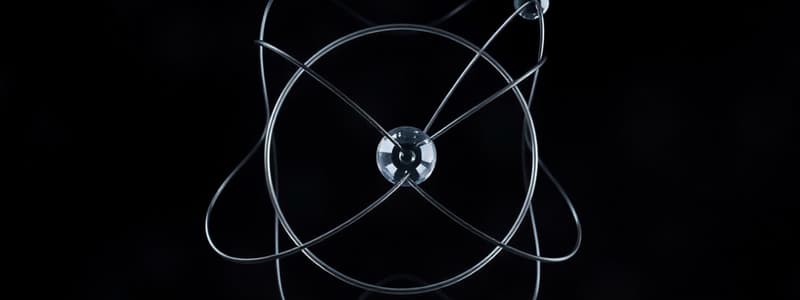Podcast
Questions and Answers
What is the term for the partial merging of atomic orbitals?
What is the term for the partial merging of atomic orbitals?
- Resonance
- Ionization
- Overlapping (correct)
- Hybridization
According to the orbital overlap concept, what determines the strength of a covalent bond?
According to the orbital overlap concept, what determines the strength of a covalent bond?
- The extent of overlap (correct)
- The size of the atoms
- The energy level of the electrons
- The number of protons
What is required for the formation of a covalent bond between two atoms, according to the orbital overlap concept?
What is required for the formation of a covalent bond between two atoms, according to the orbital overlap concept?
- Electrons with the same spin
- Pairing of electrons with opposite spins (correct)
- Electrons in the core shells
- A large difference in electronegativity
What kind of atomic orbitals overlap to form a hydrogen molecule (H2)?
What kind of atomic orbitals overlap to form a hydrogen molecule (H2)?
Which theory explains the shape and directional properties of bonds in polyatomic molecules?
Which theory explains the shape and directional properties of bonds in polyatomic molecules?
What is the HCH bond angle in a methane (CH4) molecule?
What is the HCH bond angle in a methane (CH4) molecule?
What shape does a molecule of NH3 (ammonia) have?
What shape does a molecule of NH3 (ammonia) have?
What happens to the energy state when two hydrogen atoms are close enough to form a hydrogen molecule?
What happens to the energy state when two hydrogen atoms are close enough to form a hydrogen molecule?
Which of these is NOT a polyatomic molecule?
Which of these is NOT a polyatomic molecule?
What is the main concept behind the formation of a covalent bond?
What is the main concept behind the formation of a covalent bond?
Flashcards
Orbital Overlap
Orbital Overlap
The partial merging of atomic orbitals, leading to electron pairing and covalent bond formation.
Overlap and Bond Strength
Overlap and Bond Strength
The strength of a covalent bond is determined by the extent of overlap between atomic orbitals; greater overlap leads to a stronger bond.
Covalent Bond Formation
Covalent Bond Formation
Covalent bond formation occurs when electrons in the valence shell, possessing opposite spins, pair up through the overlapping of atomic orbitals.
Valence Bond Theory
Valence Bond Theory
Signup and view all the flashcards
Study Notes
Potential Energy Curve for H2 Formation
- Illustrates the relationship between potential energy and internuclear distance in H2 molecule formation
- The curve's minimum signifies the most stable H2 state
Orbital Overlap Concept
- Occurs when atomic orbitals of two nearby hydrogen atoms partially merge
- This merging is the overlapping of atomic orbitals, leading to electron pairing
- The extent of overlap determines the strength of a covalent bond
- Greater overlap results in a stronger bond between two atoms
- Covalent bond formation involves pairing electrons in the valence shell with opposite spins
Directional Properties of Bonds
- Covalent bonds form through the overlapping of atomic orbitals
- Hydrogen molecule formation involves the overlap of 1s-orbitals of two H atoms
- Geometry is important in polyatomic molecules like CH4, NH3, and H2O
- Valence Bond (VB) Theory explains shape, formation, and directional properties of bonds in polyatomic molecules, using overlap and hybridization of atomic orbitals
Studying That Suits You
Use AI to generate personalized quizzes and flashcards to suit your learning preferences.




